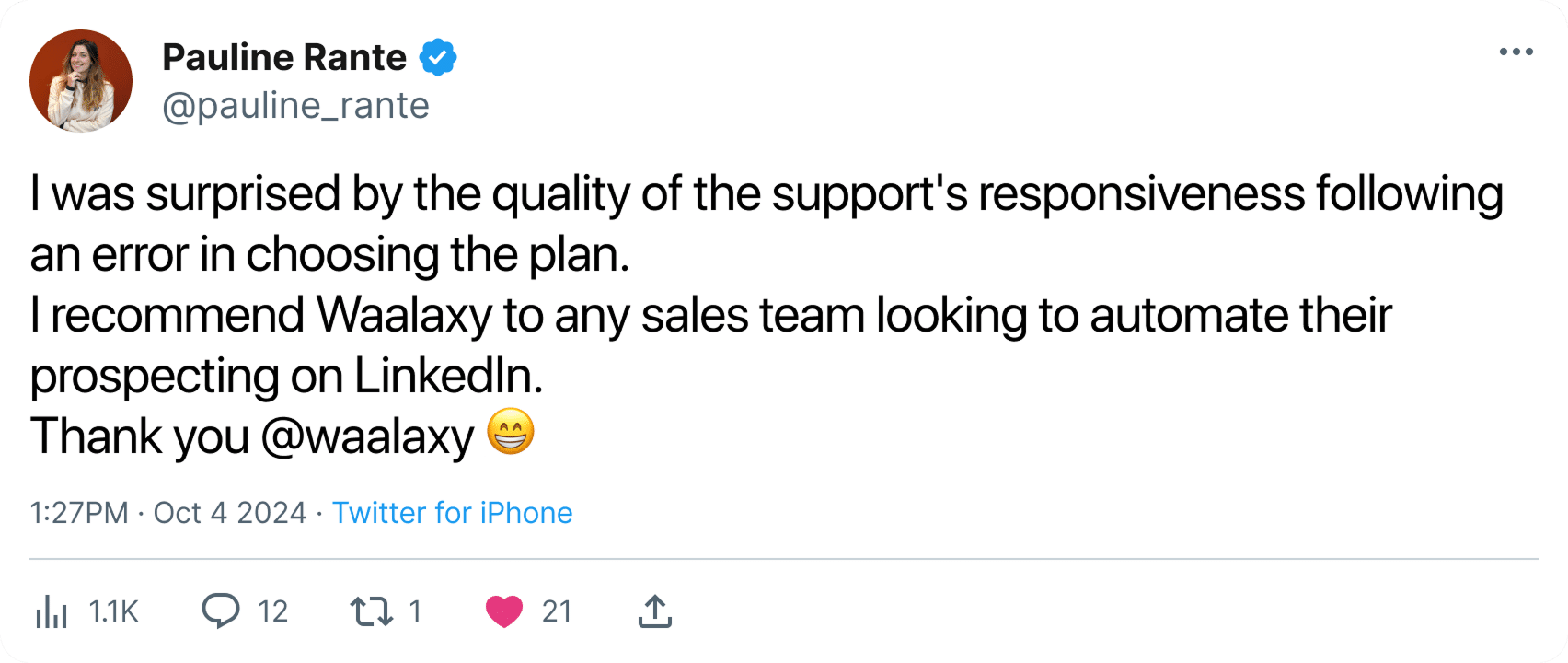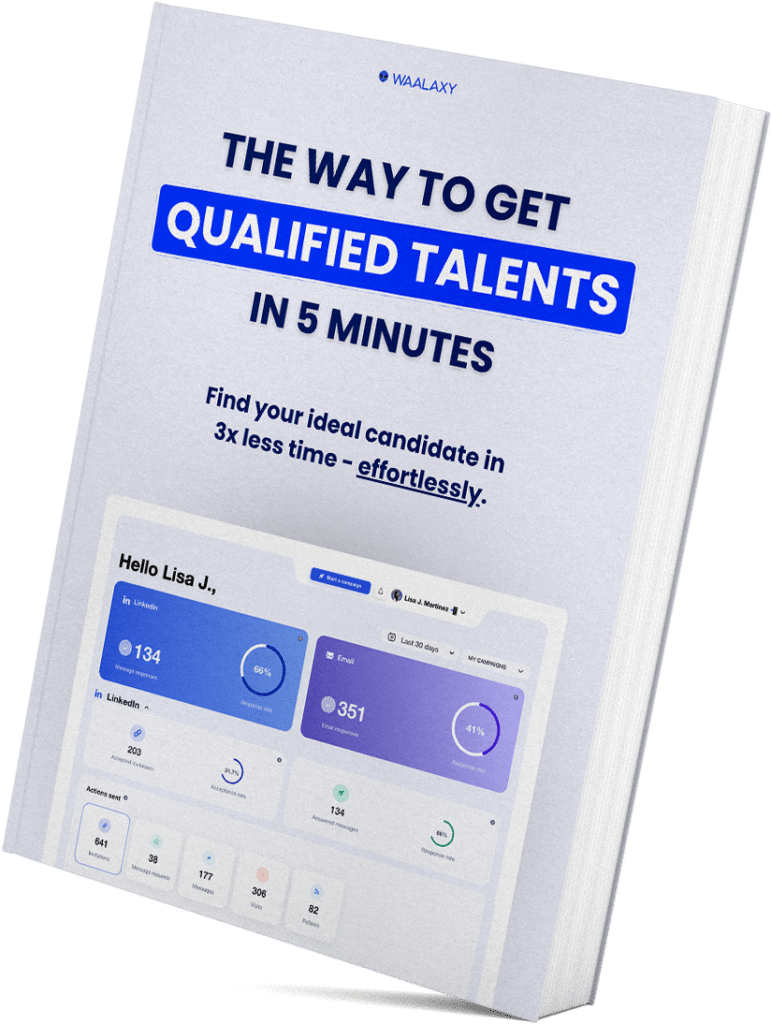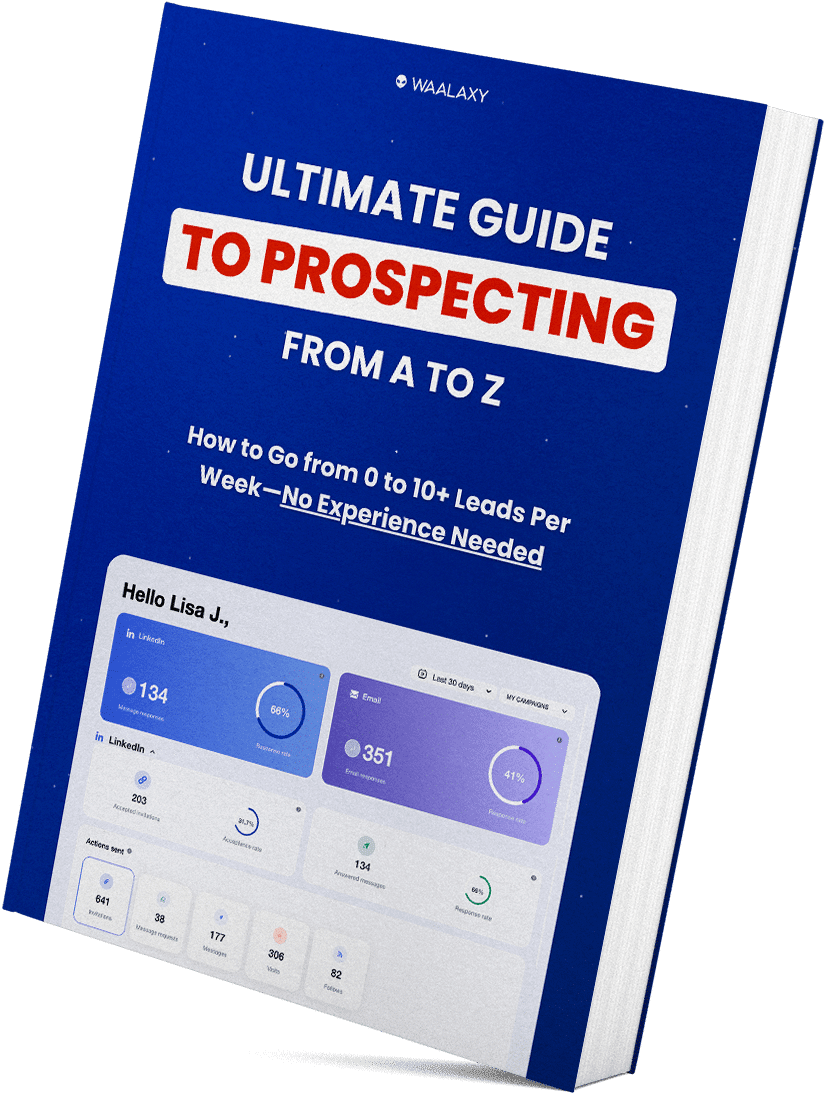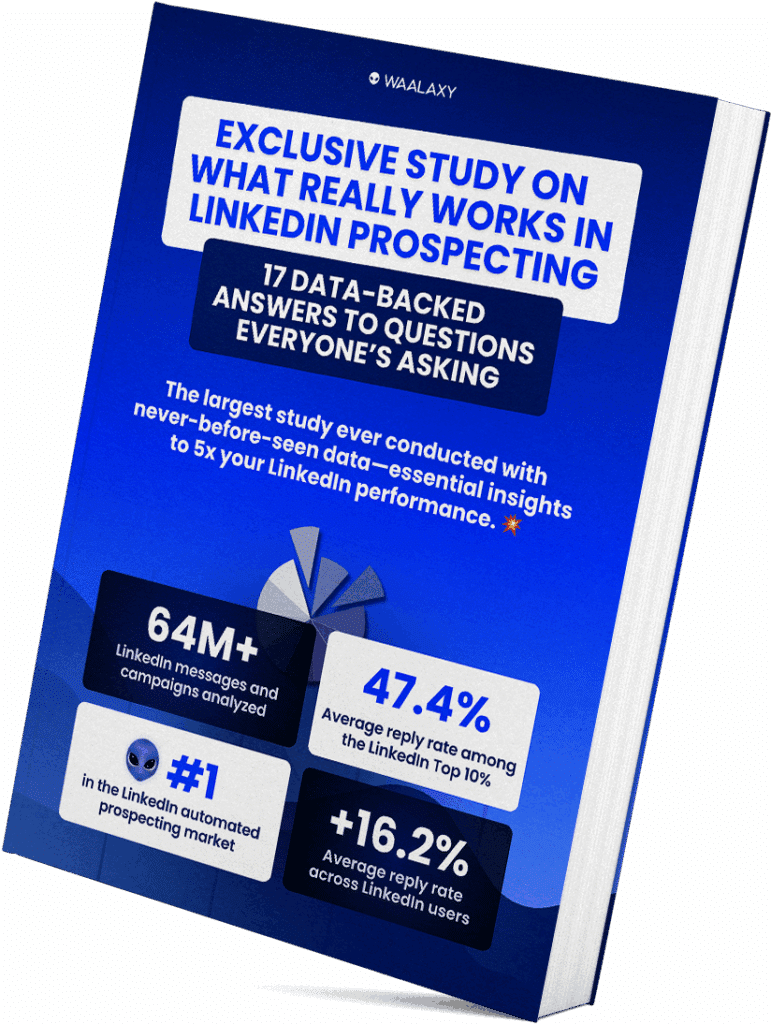- What is objection handling?
- Why is objections handling essential in sales prospecting?
- How to handle sales objections ? 10 examples
- 3 Methods of Handling Objections in Sales
- Automate sales objection handling with Waalaxy
- Shall we have a recap on how to handle an objection in sales ?
- Frequently asked questions about how to overcome objections in sales
Have you ever heard a prospect say:
“It’s not the right time…”
“Your offer is too expensive…”
And then, radio silence 😬
Don’t worry, it happens to everyone. In fact, an objection is not a “non” definitive, it’s often a sign of interest that you need to know how to decode.
In prospecting, especially on LinkedIn or by email, objections handling makes all the difference between a lost lead and a signed sale 💥
In this article, we’ll look at how to turn obstacles into opportunities, with simple methods, concrete examples and a little bonus: how to automate objections handling.🤖✨
What is objection handling?
Before you can master objection handling, you need to understand what an objection really is — and, more importantly, what it isn’t. Too many sales reps confuse refusal with customer objection, or respond too quickly without delving into the real reason for the blockage. Too many salespeople confuse refusal with objection, or respond too quickly without delving into the real reason for the blockage. Let’s start with the basics. 👇
Definition: what is a customer objection in sales?
An objection is resistance expressed by a prospect when he or she hesitates to move forward in the sales cycle.
It may relate to price, need, timing or confidence in your solution.
But beware: an customer objection is not a “non”. It’s often a “not yet”?. 😉
The prospect doesn’t necessarily reject your offer: he’s looking for reassurance.
Your role, then, is to identify what’s really blocking them, to listen without interrupting, and then to dispel any doubts with concrete evidence.
Rejection vs. Objection: the key difference in Handling Objections
This is an essential nuance that many salespeople forget. A rejection is a wall:
- “I don’t want to talk to you.”
- “Take me off your list.”
👉 In this case, there’s no need to insist: the prospect isn’t open to discussion.
An customer objection, on the other hand, is a door ajar. The prospect is interested, but not yet ready to buy.✨
Why is objections handling essential in sales prospecting?
If you’re in the business of prospecting, you already know that dealing with objections is part of everyday life. It’s not a failure, it’s an obligation. In fact, the way you handle them can literally make or break a sale. 🛍️
The role of objections handling in prospect conversion
Every objection is a hidden opportunity. A prospect who takes the time to say “it’s too expensive” or “it’s not the right time” offers you a gateway to their thinking. 🤔
By listening and responding appropriately, you :
- Strengthen your credibility. 🤓
- Build trust. 🥰
- Increase your chances of conversion without forcing your hand. 🧘🏻♀️
A salesperson who has mastered this stage does not “respond to an objection”, he or she accompanies the prospect in his or her decision. And that’s the difference between a sales negotiation and a discussion that goes nowhere.🥲
How do you know if a customer objection is real or just an excuse?
That’s the big question! Not all customer objections are created equal. Some are genuine (“the budget is locked for this year”), others are dissuasive (“I’ll think about it”) polite ways of ending the exchange. 🫠
To tell the difference, ask yourself three questions:
- Has the prospect understood the value of my solution?
- Does he have a rational (budget, timing) or emotional (fear, uncertainty) motive ?
- Does he respond consistently to my reminders?
If you sense an unclear objection, dig in with curiosity: “I understand, what’s making the moment complicated for you?” Often, with active listening and simple rephrasing reveals the real reason for the blockage. 😇
The importance of posture for sales reps when dealing with objections handling
When faced with an objection, the worst mistake you can make is to lose your temper or try to convince at all costs.
The right reflex is to step back, breathe, listen actively — and use empathy to overcome objections effectively. 💕
A good salesman doesn’t try to “win” the discussion, but to understand his interlocutor. You’re there to find out if your product really meets their needs, not to prove them wrong. 🙃
Attitude counts as much as words:
- Listen without interrupting. 👂
- Rephrase to show you’ve understood. 🧩
- Maintain a calm, open and empathetic posture. 🙌
It’s this confidence that turns a hesitant prospect into a convinced customer and creates a good customer relationship.
How to handle sales objections ? 10 examples
Let’s face it: hearing an objection always makes you cringe 😅.
But in reality, these dreaded phrases are your best indicators of interest — because objection handling in sales is all about turning hesitation into engagement. A prospect who objects is a prospect who thinks!
We’re going to break down the most common sales objections you encounter when prospecting, and above all, how to respond to them without sounding insistent. 😎
1. The price objection: “It’s too expensive”
Price is the first barrier expressed, but rarely the real one.
It’s not necessarily a question of money, it’s a question of perceived value 💸.
When a prospect says “it’s too expensive”, he’s really sending you a signal :
“I still don’t understand what’s in it for me.”
Your mission? To help the prospect reconnect the expense with its concrete benefit. It’s not the amount that gets in the way, but the vision of what he gets in return. 👀
👉 Example:
“I understand, especially if you’re just comparing the rate. But if you look at the time saved or opportunities generated over 3 months, do you think the ROI would be less than the investment?”
Rely on customer results (before/after, concrete figures, testimonials). Nothing speaks louder than tangible proof.
➡️ And if your prospect is still stuck on the price, rephrase it to get a better understanding:
“Is it a question of overall budget, or rather short-term priorities?”
2. The time objection: “It’s not the right time”
This one is formidable, because it seems reasonable. ⏳
But let’s be honest: it’s never the right time to change a tool or adopt a new solution.
Often, behind this objection lurks the fear of change or the fear of an additional workload. 😣 Your role is to help the prospect visualize what they’re losing by waiting.
➡️ For example:
“I understand, you probably have a lot of subjects on the go. But if you put it off any longer, what impact will it have on your results for the quarter?”
You could also suggest a gradual implementation. 📈
“How about launching a test version or pilot campaign on a small segment? This would allow you to measure value without upsetting your priorities.”
And with a tool like Waalaxy, you can easily automatically follow up prospects with this type of objection, via a dedicated sequence or scheduled reminder 😉
3. Competitor-related sales objections: “We’re already using another tool”
This is a common situation, especially in saturated B2B markets ⚖️
But the good news is that a prospect who is already equipped is a mature prospect. They know the problem, they’re interested, they’ve already invested.
Your aim is not to denigrate their current choice, but to position yourself as a better alternative or complement.
You can ask 👇🏻:
“That’s great, it proves that the subject is strategic for you. I’m curious to know: what do you like best about your current solution, and what would you like to improve?”
This simple question opens up a space for honesty. And often, the prospect brings up their own frustrations… which your solution can solve. 😏
Highlight the ease of transition: Data export/import, coaching, dedicated customer support… The idea is to make the change less risky and more attractive.
4. The decision-maker’s objection: “I need to talk to my manager/partner about this.”
This customer objection is not a refusal, but a transfer of responsibility 🧑💼 The prospect isn’t against it, he’s just not the only one to decide.
The classic trap is to say “OK, let me know” and lose the lead.
Instead, help him bring the discussion internally, with concrete arguments that are simple to relay.
Here’s a sample response 👇🏻:
“Great, can I send you a mini summary with the strong points, the estimated gain and some customer feedback? It’ll help you present it quickly.”
If possible, suggest a three-way meeting with the decision-maker.
Formulate it as a help, not a constraint 😎 :
“It could save you time, we answer all the questions directly together.”
And if that’s not possible, automate the follow-up with a tag “to recontact with decision-maker” in your CRM. ☎️
5. The need-based sales objection: “I’m not sure I need it.”
This is often a false customer objection, a sign that the prospect doesn’t yet see the pain you’re alleviating. The natural reflex would be to convince… Bad idea. 🙃 At this point, you need to conduct discovery again, but in a more refined way.
👉 Example of a follow-up question:
“This is interesting. Putting your current solution aside, how are you handling [the problem you’re solving] today?”
This question, asked calmly, often leads the prospect to recognize for themselves the limitations of their current system.
You’ve then just opened a natural breach into which to insert your value.✨
Write down the most frequent objections in a document shared with your sales team.
6. No budget this year: “It’s not in the forecast”
Budgets happen — and so do tight quarters. That’s okay. The key in objection handling is not to push, but to stay on their radar. 👀
💡“Totally understand, your budget’s already locked. How about a quick catch-up early next year to see if priorities have shifted?”
You can tag them as “follow-up” in your CRM so you can circle back when the timing’s right.⏳
7. Too complex: “It’s too complicated / we don’t have the capacity”
Complexity is often more of a fear than a fact. Your job is to make things feel light and doable.
“I hear you — a lot of our clients felt the same before trying it. Once they saw how quick the setup was, they were surprised at how smooth it went.”
Emphasize your onboarding process, dedicated support, and how your team holds their hand the first steps. Confidence sells simplicity.✨
8. Missing feature: “We need feature X”
This one’s a classic customer objection. Don’t panic or apologize — acknowledge, pivot, and reframe.😉
💡“That’s a great point. That specific feature isn’t live yet, but here’s what we offer that gets you the same result.”
If it’s already in your roadmap, mention it briefly: “It’s planned for Q1.” That gives reassurance without overselling the future. 😎
9. Compatibility: “It’s not compatible with our tools”
Tech customer objections can sound scary — but they’re often easier to solve than they think. 🤓
💡“Makes sense, integration’s critical. Let’s take a look together — we often connect through API or Zapier in just a few clicks.”
Keep your tone confident and collaborative. You’re not challenging their system, you’re helping them fit a new piece into the puzzle 🧩.
10. Contract / risk: “I don’t want a long-term commitment”
Long contracts can spook anyone, it’s a common customer objection. Show flexibility and shift the focus from risk to value discovery. 🤸🏼
💡“No problem at all! We can start small — no long-term commitment — just so you can see the value firsthand.”
Offering a trial or monthly option helps remove friction, lowers pressure, and keeps the sales negotiation moving naturally. 🕺🏻
3 Methods of Handling Objections in Sales
Dealing with customer objections isn’t about retaliating — it’s about understanding before responding.
The best salespeople know that overcoming objections in sales isn’t about being right, but about listening, empathizing, and reformulating 😉
Simple methods such as CRAC, ADERA or AIR serve as concrete benchmarks in any sales technique. Here’s how to use them. 😇
The CRAC method: simple, straightforward and highly effective for Handling Objections
The CRAC method remains a benchmark in sales training.
It is based on four easy-to-remember steps: Understand, Reformulate, Argue, Conclude.
- 🧩 Understand: Let your contact express his or her thoughts to the end. You must first identify the real obstacles before responding.
- 🗣️ Reformulate: Show that you’ve understood the objection. This establishes a climate of trust, essential to any successful negotiation.
- 📊 Argument: Bring in concrete facts, white papers, figures or testimonials. The argumentation must be clear, personalized and focused on the benefits for the prospect.
- ✅ Conclude: Check that the customer objection has been overcome and calmly propose the next step.
👉 Example:
“If I understand correctly, your hesitation comes from the budget? Our customers have seen a return on investment as early as the first quarter. Let’s take a look at what this would mean for you?”
This method applies particularly well to sales objectionsin digital prospecting, where every message needs to be concise, precise and value-oriented.
The ADERA method: intelligent negotiation for Handling Objections
For longer sales processes or complex deals, the ADERA method enables you to go further in understanding the prospect and thus avoid customer objections.
It structures the negotiation without losing the human touch 🤝
Welcome, Discover, Listen, Respond, Approve: five steps to move the discussion forward 👇🏻 :
- 👋 Welcomewithout getting brazen. “Thank you for your candor, it’s a point many of our customers bring up at the outset.”
- 🔍Discoverby asking open-ended questions to identify real needs. “When you say it’s not a priority, is it related to budget or your internal planning?”
- 👂 Listen without trying to interrupt or convince too quickly.
- 🗣️ Respond with a concrete, personalized argument.
- 🤝 Approveto validate mutual understanding and strengthen the relationship.
This approach puts the emphasis on discovering potential customers rather than persuading them. It fits perfectly into a consultative sales logic, where every objection becomes a point of discussion, not an obstacle. 😎
The AIR method: the express technique for digital prospecting for Handling Objections
When you’re managing dozens of LinkedIn conversations a day, you don’t have time to roll out a long script.
The AIR method is a condensed version designed for modern prospecting:
- 👀 Welcome: “I see, that’s a point many raise.”
- 🤓 Interrogate: “When you say it’s not the right time, is it related to other projects in progress?”
- 😎 Answer: “Precisely, several of our customers started small before going widespread, which reduced the risk and maximized the benefits.”
This mini-structure works very well for defusing commercial objections cold, while maintaining a natural relationship.🥶
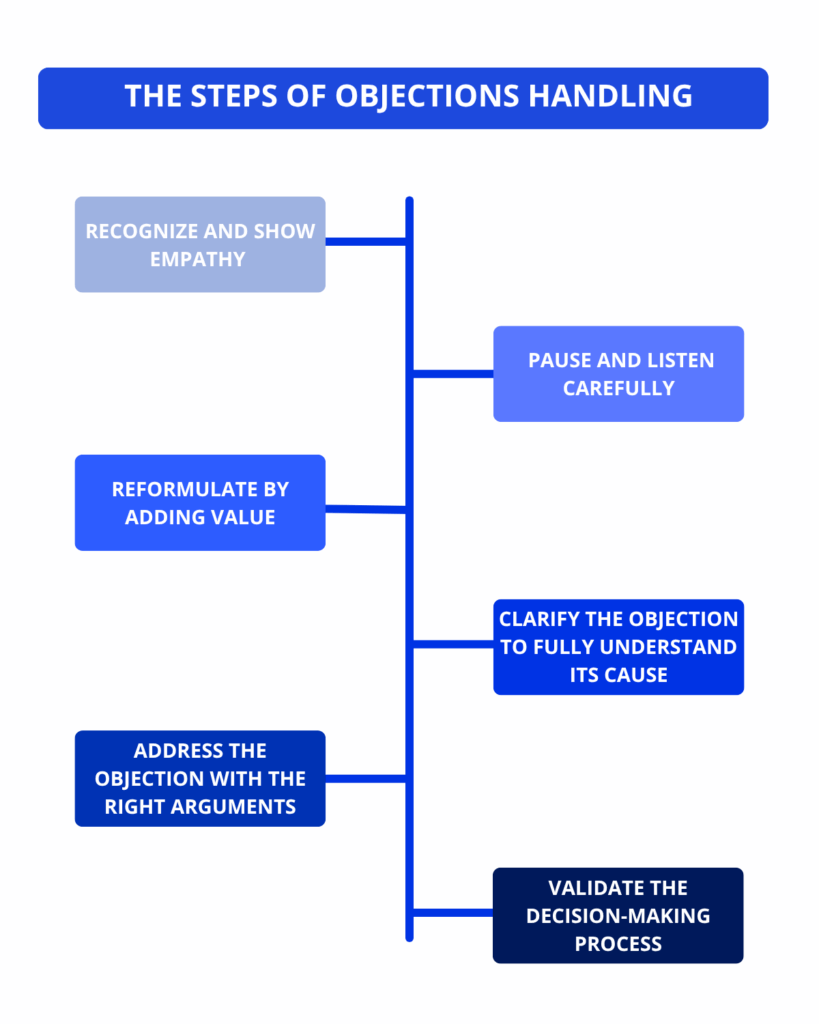
Automate sales objection handling with Waalaxy
We’re not going to lie: dealing with customer objections one by one, by hand, can be time-consuming 😅.
And yet, that’s often where your conversions come in. Good news: with Waalaxy, you can automate the handling of objections while retaining a real human touch.
How to handling email sales objections in prospecting?
Automating does not mean “robotizing”. On the contrary, it’s a way to better personalize your exchanges, anticipate obstacles, and react faster to signals sent by your prospects thanks to Waalaxy campaingns 🚀.
1. Segment and personalize your messages and mail
From the very first responses to your campaign, the tool helps you identify types of email sales objections (price, timing, need…).
Thanks to segmentation and personalized tags, you can tailor your follow-up:
- Tag a prospect “interested but not available”. 👀
- Automatically relaunch 3 weeks later. ⏰
- Send a specific message to those who mention price 💸
2. Analyze sentiment in messages
One of Waalaxy’s great strengths is its sentiment analysis system 🤖.
In concrete terms, the tool acts like an “emotional” lead scoring: it spots whether your prospects’ responses are positive, neutral or negative, then automatically assigns them a 🎯 tag.
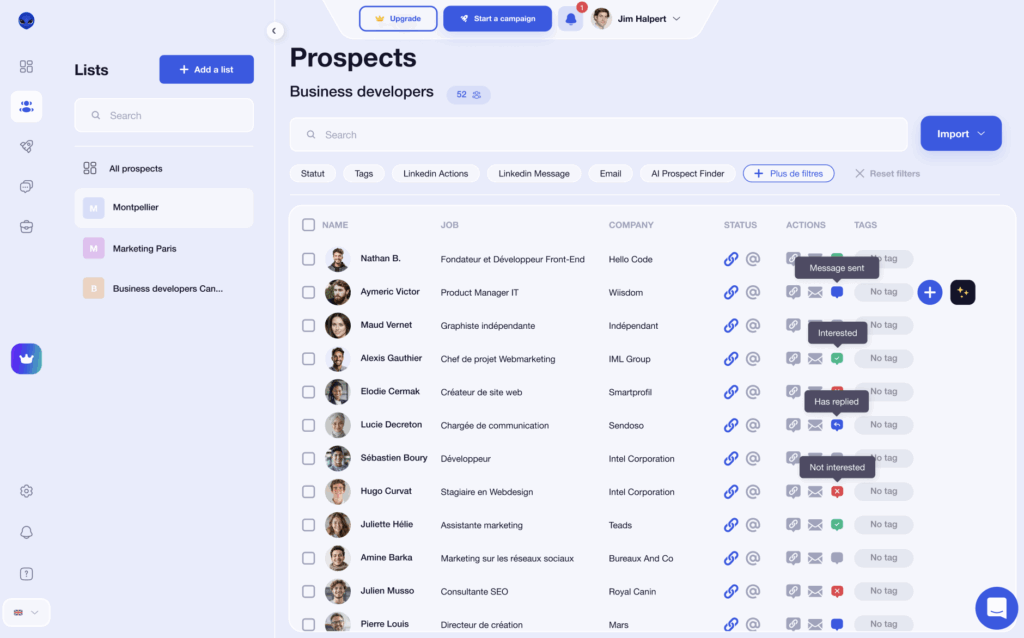
The result? In the blink of an eye 👀 you know where to concentrate your efforts and when to follow up your most promising leads.
This enables you to anticipate objections, to adapt your sales pitch according to the tone of the message received a hesitant response doesn’t call for the same approach as an interesting “, but not now”. 😎
3. Relaunch without being intrusive
We all know it: relaunching too soon or too loudly is the best way to drive a prospect away 😅.
With Waalaxy, you can program an automatic reminder in your inbox 📬 to get back in touch at just the right moment.
The idea is not to harass, but to follow up with intelligence. The tool then becomes your intelligent sales assistant, helping you close the sale without pressure or heaviness 💪.
4. Continuously test and improve your scripts
Sales objections handling is never set in stone 📊.
What works with one prospect may fall flat with another, and that’s where Waalaxy becomes a real testing laboratory 🔬.
Thanks to A/B testing, you can compare several approaches:
- A direct, concise tone 💬.
- An empathetic response 💛.
- An argument centered on the ROI of the product or service 💼.
The tool then measures the performance of each version: response rate, engagement, conversion. Little by little, you build a data-driven sales pitch, based on concrete results rather than guesswork. 😍
5. Make the most of your campaign data
Every message you send is a goldmine of information 💎.
By analyzing your data, you can spot recurring customer objections, adjust your waalaxy sequences and strengthen your sales pitch 📚.
Create a “draft” sequence for prospects who weren’t ready “” a few months ago.
By adding a personalized touch (“I remembered the timing wasn’t ideal this summer…”), you relaunch without insisting and rekindle the conversation 🔄
Shall we have a recap on how to handle an objection in sales ?
Objections handling is above all a question of listening, posture and added value. ✨
A good salesman doesn’t try to force the sale, but to reassure, understand the brakes, and turn the discussion into a real win-win commercial negotiation. 🤝
By mastering overcoming objections, improving your handling objections in sales skills, and applying effective objection handling techniques, you’ll move from “I’m not sure” to “why not”, while building a lasting relationship of trust.😎
You can also use the Challenger Sale method to shake up customers’ certainties, help them see things differently, challenge them with new ideas, insights and a tailored value proposition.✨
And with Waalaxy, you can go even further: anticipate, personalize, and automate — without ever losing the human touch. 🚀
Frequently asked questions about how to overcome objections in sales
How to avoid objections?
The best way to avoid customer objections is to anticipate them even before the first contact.
Two simple levers make all the difference:
- Good segmentation 🎯: Target the right prospects, at the right time, with a message tailored to their level of maturity.
- A clear, personalized prospecting message 💌: The more human and relevant your approach seems, the less your contacts will feel the need to defend themselves or “justify” a refusal.
In short, good targeting and the right message means fewer objections, more constructive conversations.
How can you train your sales team in Handling Objections?
Training your sales team to handling sales objections means helping them to become more comfortable, confident and consistent in what they say. Here’s a practical, effective approach 👇
- Create a database for objections handling 📚 :
List the most frequent customer objections and draft standard responses adapted to each situation. This serves as a common benchmark for the whole sales team and helps them improve their handling objections and overcoming sales objections skills over time. - Rely on social proof 💬 :
Show customer testimonials and real-life cases. This is a great way to build credibility and help your sales people reassure their prospects. - Integrate a prospecting tool like Waalaxy ⚙️ :
Waalaxy automates prospecting while tracking sales objections.
Your teams can test different messages, analyze reactions, and continuously refine their sales pitch to get better at overcoming sales objections.
Now you know everything there is to know about customer objections handling ! 🧚🏻♀️


